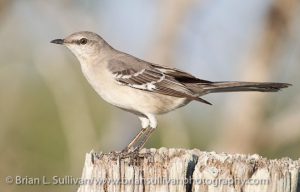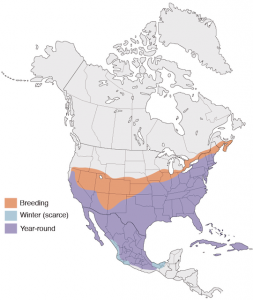Northern Mockingbird: Mimus Polyglottos
Appearance
The mean total length of male mockingbirds is about 24 cm, that of females is 23 cm (Derrickson and Breitwisch 2011). Sexes are very similar in appearance, with long legs and long tails, and gray back coloration with a black posterior border on the wings. Adults also have two white wing bars, and their underbellies tend to be grey or grey-white (Derrickson and Breitwisch 2011). Juvenile mockingbirds have darker grey plumage, but are very similar to adults. The bill of mockingbirds are medium-lengthed and slightly curved.

Adult mockingbird
(https://birdsna.org/Species-Account/bna/species/normoc/appearance)
Social Behaviors
Mockingbirds spend most of their lives in pairs, but as juveniles sometimes form larger flocks (Derrickson and Breitwisch, 2011). Mockingbirds are known for their mimicking song and aggressive defense of their territory and nests. A distinctive characteristic of mockingbird behavior is wing-flashing, a behavior first performed as a juvenile, and continued into adulthood, especially by female birds returning to their nest after an extended period. Although the purpose of these wing flashes is unknown, it has been theorized that it is an anti-predation mechanism, and is most common in the nesting and fledgling periods of breeding (Derrickson and Breitwisch, 2011).
In addition to chasing away intruders to their territories, mockingbird males perform “boundary dances,” which have been found to serve as a defense function warning other males near their boundary (Derrickson and Breitwisch, 2011).
Mating behaviors
Mates tend to be monogamous couples, and often have winter territories and territories for the breeding season. The male and female partners share most of the parental responsibilities, and can stay together for many years. Males are known to perform several displays, including a flight display in which he makes short jumps up and down on a tree branch, and a flight in which both birds are involved, the male chasing the female (Derrickson and Breitwisch, 2011).
Males and females both contribute to nest construction, with males building most of the twig foundation to the nest, while females construct most of the lining. A male may start several nests before the female lays a clutch of eggs, perhaps so that the couple has several options to choose from (Derrickson and Breitwisch, 2011). Eggs tend to be the color of the ground, and can be blue-grey as well. Females do almost all of the brooding of chicks, and both parents bring food to their young, which consists mostly of invertebrates (Derrickson and Breitwisch, 2011).
Distribution:
The species’ breeding range includes most of the United States, and extends south into southern Mexico, and can also include parts of southern Canada (Derrickson and Breitwisch, 2011). The winter distribution is largely similar, as many birds remain in the same location year-round. The birds do not usually migrate, instead spending the entire year in one location. Mockingbirds tend to inhabit sparsely-shrubbed areas, especially in cultivated and desert areas of land. Although they frequently live on the edges of forested areas, mockingbirds are very rarely found to live within forests themselves, much preferring open landscapes where they tend to forage with some nearby small trees and bushes for nesting and cover (Derrickson and Breitwisch, 2011).

Mockingbird Distribution
(https://birdsna.org/Species-Account/bna/species/normoc/introduction)
Citations:
Derrickson, K. C. and Breitwisch, R. 2011. Northern mockingbird. Birds of North America. https://birdsna.org
